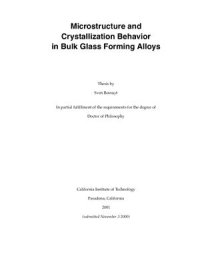
Ebook: Microstructure and Crystallization Behavior in Bulk Glass Forming Alloys
Author: Bossuyt S.
- Genre: Technique // Metallurgy
- Tags: Металлургия и обработка металлов, Металлургия, Кристаллизация металлов и сплавов
- Language: English
- pdf
Pasadena: California Institute of Technology, 2001. - 85 p.The solidification microstructure in wedge-shaped castings of Cu-Ni-Ti-Zr glass forming alloys is investigated, while the composition was systematically varied. Near the critical thickness for glass formation, a spatially inhomogeneous dispersion of nanocrystals is observed, where spherical regions contain a much higher density of nanocrystals than the surrounding material. This microstructure
is inconsistent with the prevalent theories for crystallization in metallic glasses, which predict a spatially uniform distribution of crystals.
The spatial localization of the nucleation density is attributed to a recalescence instability. Linear stability analysis of the equations for heat flow coupled with crystal nucleation and growth reveals that at low temperature recalescence can occur locally, triggered by a small fluctuation in the early stages of the crystallization process, because in deeply undercooled liquids the nucleation rate
increases with temperature. The localized recalescence events and their interaction accelerate crystallization; consequently they are important in determining the glass forming ability as well as the microstructure of these alloys.
The composition dependence of the critical thickness for glass formation, determined from the observed microstructures, and in situ small angle scattering results indicate that the crystallization occurs in several steps, involving competing crystalline phases.
is inconsistent with the prevalent theories for crystallization in metallic glasses, which predict a spatially uniform distribution of crystals.
The spatial localization of the nucleation density is attributed to a recalescence instability. Linear stability analysis of the equations for heat flow coupled with crystal nucleation and growth reveals that at low temperature recalescence can occur locally, triggered by a small fluctuation in the early stages of the crystallization process, because in deeply undercooled liquids the nucleation rate
increases with temperature. The localized recalescence events and their interaction accelerate crystallization; consequently they are important in determining the glass forming ability as well as the microstructure of these alloys.
The composition dependence of the critical thickness for glass formation, determined from the observed microstructures, and in situ small angle scattering results indicate that the crystallization occurs in several steps, involving competing crystalline phases.
Download the book Microstructure and Crystallization Behavior in Bulk Glass Forming Alloys for free or read online
Continue reading on any device:

Last viewed books
Related books
{related-news}
Comments (0)